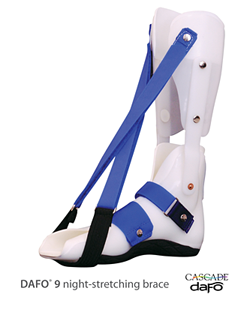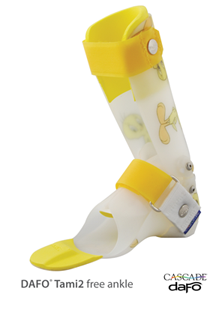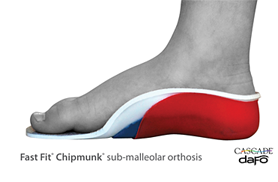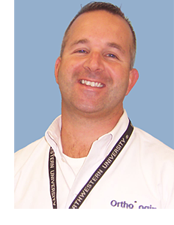|
Orthologix brings you quarterly information to keep you current on industry news, trends and insights. Orthologix is an orthotics and prosthetics practice delivering evidence-based care throughout the Delaware Valley.

FEATURED PRODUCT
Cascade DAFO® Pediatric Orthoses: DAFO® 9, DAFO® Tami2, and Fast Fit® Chipmunk®
 Cascade DAFO introduced the first Dynamic Ankle Foot Orthosis (DAFO) more than 25 years ago. Cascade Dafo's products are primarily geared toward pediatric patients, most of whom have neuromuscular challenges, but many adults also benefit from their innovative design concepts. Cascade DAFO introduced the first Dynamic Ankle Foot Orthosis (DAFO) more than 25 years ago. Cascade Dafo's products are primarily geared toward pediatric patients, most of whom have neuromuscular challenges, but many adults also benefit from their innovative design concepts.
DAFO® 9 Adjustable Night-Stretching Brace
The DAFO 9 is an adjustable stretching-positioning brace. Calf muscles and tendons are gently stretched to increase range of motion while maintaining foot and ankle alignment.
The DAFO 9 may be used for limited daytime use and/or as part of a night-stretching program. The stretching straps of the articulated proximial section allow positional adjustment in order to help gain or maintain ankle range. The elastic sections of the stretching straps provide a more effective stretch. The DAFO 9 has superior hindfoot and forefoot control, promoting proper foot positioning. The soft foam liner is ideal for patients with challenging foot anatomy, difficult-to-correct feet, or those prone to pressure points and irritation.
Key Features:
- Custom fabricated from cast
- Defined plantar surface contours
- Full wrap-around shell for flexible control of foot position and alignment
- Fully integrated padding
- Light, soft plastic outer shell improves comfort and compliance
- Elastic sections of stretching straps allow occasional "escape" from stretch, making patient more relaxed and comfortable
- Extended toe shelf trimline allows even pull of entire foot-bed
Indications:
- Lack range of motion at the ankle due to tight calf muscles and achilles tendon
- Would benefit from passive, adjustable stretching when resting or sleeping to improve range of motion
DAFO® Tami2
 Tamarack hinged, full dorsal wrap with free ankle trimline option
Tamarack hinged, full dorsal wrap with free ankle trimline option
Ideal for active ambulators who would benefit from additional medial-lateral support due to strong excess pronation or supination. For patients having trouble with drop foot during swing phase, the design can include dorsi-assist joints.
Key Features:
- Custom fabricated from cast
- Defined plantar surface contours
- Fully integrated padding
- Thin polyethylene inner liner for streamlined support, comfort, and flexibility
- Posterior upright features a no-stop trimline to allow a natural free ankle motion (also available with a PF block). Reduced outer frame trimlines make shoes fit easier.
- Free motion or dorsi-assist hinge Tamarack Flexure Joints in 75, 85, or 95 durometer resistance
DAFO Tami2 with Standard PF Block Trimline
Ideal for active ambulators with a tendency toward excessive plantarflexion and knee hyperextension who would benefit from additional medial-lateral support, with the option to add a dorsi-assist hinge.
Key Features:
- Custom fabricated from cast
- Defined plantar surface contours
- Fully integrated padding
- Thin polyethylene inner liner for streamlined support, comfort, and flexibility
- Posterior upright features a standard PF stop block; an adjustable PF stop block is optional.
- Free motion or dorsi-assist Tamarack Flexure Joints in 75, 85, or 95 durometer resistance
Product information video –
Understanding the DAFO Tami 2
Fast Fit® Chipmunk® Sub-Malleolar Prefabricated Orthosis
 The Chipmunk's ortho-engineered solution is a step forward in comfortable realignment and maximum stability of the moderately-pronated pediatric foot. Its advanced design offers separate internal alignment and external stability—allowing each of these components to function well without compromise. For such a low profile, this sub-malleolar solution provides an unprecedented degree of support.
The Chipmunk's ortho-engineered solution is a step forward in comfortable realignment and maximum stability of the moderately-pronated pediatric foot. Its advanced design offers separate internal alignment and external stability—allowing each of these components to function well without compromise. For such a low profile, this sub-malleolar solution provides an unprecedented degree of support.
Key Features
- Medial trimline covers the navicular and protects it from rubbing
- Fabric liner keeps feet cool and comfortable
- Flattened toe shelf leaves room for toes within the shoes, and can be trimmed to fine-tune the fit. Allows for addition of toe rise pad when desired
- Bottom plastic base diagonal forefoot trimline facilitates natural push-off. Full heel cup for stabilization
- Plantar surface supports good foot alignment with soft, resilient, foam contours
- Wide size range, fit to measure Widths: Wide and Narrow
Sizes: 4.00 - 12.25 in. (.25 in. increments)
Indications:
- Fully-correctable foot positions
- Mild to moderate low tone pronation
Contraindications:
- Uncorrectable foot positions
- Supination
- Strong high tone pronation
Back to top

CASE STUDY
"Multiple Presentations & Therapy Goals"
Schwartz, Vicki and Sheldon, Loretta.
Dafo Dynamics, Winter 2010.
Meet Austin. A sharp-dressed little man with an impressive vocabulary and a vivacious personality, this six-year-old is one of our favorite patients. Born prematurely at 27 1/2 weeks, Austin suffered a grade III intraventricular hemorrhage three days after birth which required placement of a ventroperitoneal shunt and, later, a diagnosis of spastic diplegia. Never without his trademark grin, Austin is a highly-motivated kiddo with an unfailing determination to succeed.
Austin's case is a prime example of how external circumstances can play a critical role in the brace selection process. www.dafodynamics.com/winter2010_casestudy/case-study-multiple-presentations-therapy-goals.html.
Back to top

FOOT ORTHOSES
"Evolution of Foot Orthotics—part 2: Research Reshapes Long-Standing Theory"
Ball KA, and Afheldt MJ. Journal of Manipulative and Physiological Therapeutics. 2002 Feb; 25(2):125-134
Key outcomes
Numerous studies show that patterns of rearfoot inversion/eversion cannot be characterized either by foot type or by orthotics use. Rather, subtle control of internal/external tibial rotation appears to be the most significant factor in maintaining proper supination/pronation mechanics. Recent evidence also suggests that proprioceptive influences play a large, and perhaps largely unexplored, role.
Read this article online (may require a journal subscription)
"The Influence of Foot Orthoses on the Function of a Child with Developmental Delay"
George D, and Elchert L. Pediatric Physical Therapy. 2007 Winter; 19(4):332-336
Key outcomes
Five items from the Peabody Developmental Motor Scale II (rise to stand, standing, lowering, cruising, and stepping forward) were tracked over three weeks, under three conditions: with shoes and orthoses, shoes only, and barefoot. The ability to perform these items was improved when wearing shoes and orthoses. Future study needed of the modified stabilizing foot splint as an intervention.
Read this article online (may require a journal subscription)
"The Effects of Foot Orthoses on Gait in New Walkers with Down Syndrome"
Looper FE, Ulrich DA. Pediatric Physical Therapy. 2006 Spring; 18(1): 96-97
Key outcomes
Hard to find statistically significant results but suggest that a relatively small amount of support to the foot improves stride width, though RDS increased with size. Early use of orthoses may have far reaching consequences for better gait quality, skill emergence, physical activity.
Further research needed. Larger sample size, include adaptation period.
Read this article online (may require a journal subscription)
"Dynamic Foot Orthosis and Motor Skills of Delayed Children"
Pitetti K, Wondra V. Journal of Prosthetics and Orthotics. 2005; 17(1): 21-24
Key outcome
DFOs improved significantly balance and locomotor skills in all patients.
Read this article online (may require a journal subscription)
"The Effect of Gross Motor Therapy and Orthotic Intervention in Children with Hypotonia and Flexible Flatfeet"
Ross C.G., and Shore S. Journal of Prosthetics and Orthotics. 2011July; 23(3): 149-154
Key Outcomes
Although gross motor therapy alone may have improved some gait parameters toward age-appropriate norms in young children with hypotonia and flatfeet, the addition of orthoses also significantly modified the arch index, possibly preventing long-term complications.
Read this article online (may require a journal subscription)
Back to top

HINGED AND DYNAMIC AFOs
"The Effect of Hinged Ankle-Foot Orthosis on Gait and Energy Expenditure in Spastic Hemipegic Cerebral Palsy"
Balaban B, Yasar E, Dal U, Yazicioglu K, Mohur H, Kalvon TA. Disability and Rehabilitation. 2007; 29(2):139-44.
Key outcomes
The hinged AFO is useful in controlling dynamic equinus deformity and reducing the energy expenditure of gait in children with hemiplegic spastic cerebral palsy.
Read this article online (may require a journal subscription)
"The Effect of Dynamic Ankle Foot Orthoses on Function in Children with Cerebral Palsy"
Bjornson KF, Schmale GA, Adamczyk-Foster A, McLaughlin J.
Journal of Pediatric Orthopedics.2006 Nov/Dec; 26 (6): 773-776
Key outcomes
Immediate, significant improvements in crawling/kneeling, standing, walking/running, jumping functions of young CP patients who are independent walkers. Free PF with pronation-supination control improved gross motor skills.
Further research needed: Long-term effect; influence of DAFO on motor skills as child develops; larger study samples; context of child's day-to-day life; measure effects from multiple perspectives of child, parent, school staff, as well as more objective measures.
Read this article online (may require a journal subscription)
"Effect of Hinged Ankle-Foot Orthoses on Standing Balance Control in Children with Bilateral Spastic Cerebral Palsy"
Rha DW, Kim DJ, Park ES. Yonsei Medical Journal.2010 Sept 1; 51(5):746-52.
Key outcomes
Hinged AFOs for children with CP may be helpful in improving the postural control mechanisms but not the postural stability in quiet side-by-side standing.
Read this article online (may require a journal subscription)
"Stair Locomotion in Children with Spastic Hemiplegia: the Impact of Three Different Ankle Foot Orthosis (AFOs) Configurations"
Sienko S et al. Gait & Posture. 2002 Oct; 16(2):180-187
Key outcomes
At the ankle, the hinged AFO provided the greatest amount of dorsiflexion during stance. All AFOs reduced plantarflexion in comparison to barefoot. The results of this study indicate that for children with spastic hemiplegia the use of an AFO did not impair stair ambulation.
Read this article online (may require a journal subscription)
Back to top

PROFILE
 John Izak, CPO
John Izak, CPO
John Izak, CPO, and partner in Orthologix, Inc., specializes in pediatric orthotics and works with children's specialized hospitals and facilities throughout Pennsylvania and the Delaware Valley. He has developed unique bracing applications, which have enabled positive outcomes for even the most difficult cases. As an educator, Izak provides ongoing seminars to allied health-care professionals on advancements in pediatric orthotics and participates in a variety of research projects.
Izak travels to South America and the Middle East frequently to provide much needed orthotic care as well as education and training.
He is a member of the Association of Children's Prosthetic and Orthotic Clinics, International Society of Orthotists and Prosthetists, American Academy of Orthotists and Prosthetists, National Association for the Advancement of Orthotics and Prosthetics, and the Pennsylvania Orthotic and Prosthetic Society. He is a recipient of the 2008 Pennsylvania Physical Therapy Association Fellowship Award
A 1986 graduate of Temple University, Izak began his career as a recreational therapist at Abington Hospital. He attended Northwestern University School of Medicine where he studied orthotics and prosthetics and received his certification from the American Board for Certification in Orthotics, Prosthetics, and Pedorthics in 1996.
In addition to his clinical work, Izak lectures and teaches at facilities throughout Pennsylvania and New Jersey. He is the volunteer Fire Chief for the Nottingham Fire Department in Bucks County, Pa.
Back to top

CONFERENCE
APTA'S 2013 Conference & Exposition, June 26-29, Salt Lake City
For more information, www.apta.org/Conference
Back to top

WORKSHOP
Introduction to Dynamic Bracing
Friday, March 22, 8:30 a.m. – 3 p.m.
Orthologix Orthotic and Prosthetic Center of Excellence
2655 Interplex Drive
Suite 101
Trevose, Pa. 19053
Course Description
This one-day workshop, open to pediatric therapists, provides an overview of the Cascade Dafo system of pediatric bracing. Discussion will include common gait deviations in the pediatric population and the range of lower extremity bracing solutions available for consideration. Through a combination of lecture, patient videos, hands-on activities, and group discussion, participants will gain an understanding of how to effectively utilize a DAFO® (Dynamic Ankle Foot Orthosis) to improve patient outcome.
Presenter
Cidny Fox, CPO, FAAOP Cidny has a B.A. from the University of Washington and has specialized in pediatric orthotic work since 1986. She works at Orthotic Solutions, LLC in Fairfax, Virginia, and has been teaching for Cascade Dafo since 1994. A highly respected practitioner, Cidny maintains exacting standards and a wealth of knowledge that greatly benefit her patients and students alike.
CEUs available — six classroom hours for Physical Therapists. Lunch provided.
Register by March 13, 2013
Click here for PDF of registration form and workshop information.
Questions?
Call 800.848.7332 ext. 285 or email workshops@dafo.com
Back to top

LEGISLATIVE NEWS
Medical Excise Tax Does Not Affect Orthotic & Prosthetic Components
Good news for your patients. The Treasury Department has ruled that prosthetic and orthotic devices, including therapeutic shoes, are exempted from the 2.3 percent medical device tax under the retail exemption provided in the Affordable Care Act.
The Treasury Department ruling resulted from intense efforts by the American Orthotic and Prosthetic Association (AOPA) that O&P devices qualify for the safe harbor (protection from liability or penalty) provision "considered to be of a type generally purchased by the general public at retail for individual use." Also exempted are eyeglasses, contact lenses, and hearing aids. [Devices that require implantation or insertion by a medical professional are not exempted.]
AOPA had several specific meetings and consultations with IRS and Treasury beginning nearly two years ago explaining why O&P devices were eligible for this retail exemption.
AOPA also was successful that this retail exemption should apply to the manufacturers of O&P components because that tax "would just be shifted higher up the distribution chain," – meaning the patient.
This is a dramatically important and favorable outcome for O&P in this final rule. It is clear that companies that manufacture components that are used by a patient care facility provider to fabricate an exempt O&P device (under the safe harbor rule) are also exempt.
What this means for patients is that all custom-made orthotic and prosthetic devices will not cost an additional 2.3 percent to build. This will keep patient co-pay, deductibles, and cost at the same current rate (per your insurance company).
Back to top

Q & A
Please feel free to submit your questions on the Cascade DAFO® as well as any other issue you would like addressed.

Back to top

Educational Workshops and Inservices
Orthologix is available to present educational workshops and inservices for your group or your facility. Email us at info@orthologix.com to schedule.

We hope you have found this issue of the Orthologix E-news informative.
Thank you for your subscription.
Back to top
|